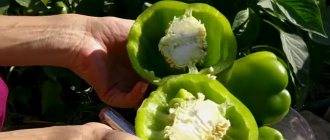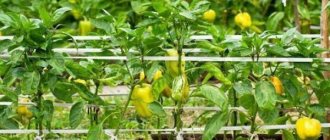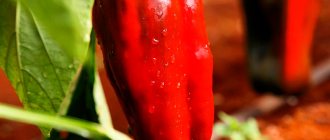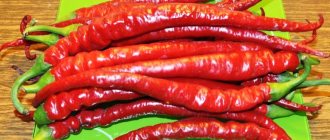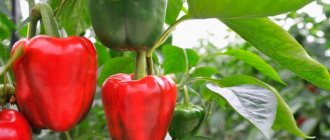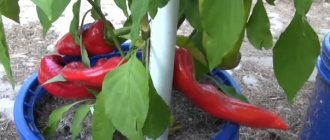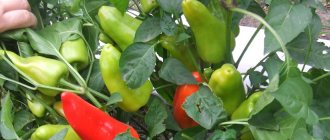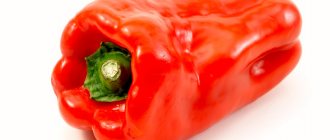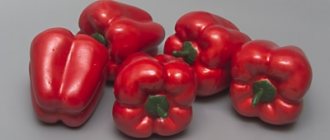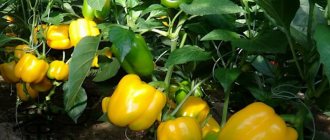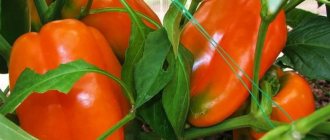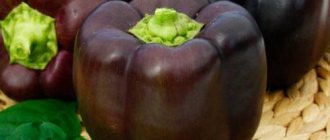Sweet peppers are very popular among gardeners. The Agapovsky variety appeared thanks to the ongoing work of breeders who sought to obtain more attractive characteristics and properties. Agricultural methods for the healthy vegetable are constantly being improved, which helps to increase its productivity and resistance to adverse weather conditions. Pepper "Agapovsky" decorates many gardens with its bright fruits and lush bushes. It is appreciated for its excellent taste.
Description and characteristics of the variety
Agapovsky is intended for cultivation in film shelters in all regions of the country, even in its northern part.
Seedlings are planted outside and grown in the Krasnodar Territory and Crimea. In warm climate zones, plants grow well in outdoor soil and tolerate slight cold spells without problems. The bushes are compact in size, rarely exceeding a meter in height, but are very leafy. Foliage can inhibit reddening of peppers, so its growth must be controlled. The ripening period of peppers is early: 100-120 days pass from the moment the seeds germinate until the onset of biological maturity. The productivity is very high: from a planting meter in a good season it is possible to collect 10-12 kg of selected fruits.
Peppers at the stage of technical maturity are green in color, then after 2-3 weeks it changes to red. The harvest can be ripened at home; this will not affect the taste or quality.
The weight of the fruit ranges from 100 to 150 g, but sometimes it can be 200 g or even 300. The shape is prism-shaped, with clearly visible edges. The stalk is not pressed inward. The thickness of the skin is 6-8 mm. The taste is juicy with sweet, pleasant notes. The amount of sugar in the juice is 3.6%, the dry matter content is 6.4%.
The purpose of Agapovsky pepper is universal. The fruits are suitable for cutting into salads, suitable for stuffing and for making preparations. The thick skin retains all the juice inside during cooking and does not spread.
Attention! The Agapovsky variety is suitable for long-term storage and transportation, so it is often grown for sale.
The Agapovsky variety has high disease resistance. The crop is weakly affected by tobacco mosaic virus and root rot. Preventive treatments with fungicides are welcome and will only strengthen the plants’ strong immunity. The shoots normally survive short droughts and are not too demanding on lighting, even at the initial stage of cultivation. The advantages of the Agapovsky variety include:
- excellent fruit quality;
- marketable condition;
- early ripening;
- compactness of bushes;
- resistance to diseases and pests;
- abundant yield;
- unpretentiousness in breeding.
Peppers have no disadvantages. The variety still competes strongly with new hybrid varieties and has not lost its popularity among gardeners.
Characteristics and description
The plant looks advantageous compared to other varieties of peppers: a strong bush with bright emerald greens, sprinkled with beautiful fiery fruits, similar to imported hybrids, as they are smooth, large and fleshy.
What does the bush look like:
- Compact, medium size.
- The height is about 90 cm, which allows it to be grown under arches and makes it easier to care for.
- The leaves are large, dark green, and the bush is heavily leafy.
- The fruits are arranged “drooping”, like bells.
- Large, on average their weight is 100–120 g, but with special care they can reach up to 400 g.
- The fruits have an elongated, prism-like shape, 12–15 cm long.
- Thick-walled, with juicy pulp 5–7 mm thick, sweet: dry matter – 6.4%, sugar – 3.6%, vitamin C – 206 mg per 100g.
- Peppers are bright red when ripe, but when technically ripe they have a dark green color.
- The fruit is slightly wavy, the stalk is slightly depressed.
- Very fragrant.
- The larger the fruit, the more pulp.
Characteristics of the variety
Pepper "Agapovsky" is an annual vegetable crop characterized by early fruiting. The first harvest is harvested 100-110 days after emergence. The bushes grow compact. The low plant is densely covered with large dark green leaves.
Large fruits have a prism-shaped shape. Their surface is smooth and slightly ribbed. The fruits hang from the stems with the top down. Their weight reaches 115-120 g. The thickness of the fleshy wall is 5-7 mm. The fruits have a pleasant taste and delicate aroma. At technical ripeness they are characterized by a dark green color, and at biological ripeness they are bright red.
The “Agapovsky” variety is distinguished by its high yield. During the season, from 1 m2 you can collect 9-10 kg of juicy fruits. The more often they are removed from the bush, the more new ovaries are formed.
On a note! To increase the yield of sweet peppers, the flower of the first branch must be removed.
Agapovsky pepper is resistant to viral and fungal diseases. Rarely affected by tobacco mosaic and blossom end rot. Sometimes aphids and spider mites settle on the plant. Calendula, marigolds and basil will help repel insect pests. They are planted between rows or around pepper beds.
Features of planting and growing
Like other varieties of sweet pepper, Agapovsky is grown through seedlings. If you want to save space on the windowsill for some time, the seeds can be planted in a common small box, but at the stage of 2-3 true leaves, the seedlings will still have to be planted in separate pots, so it is better to sow immediately in individual containers: plastic cups or peat pots. The seedlings of this pepper grow quite compact, so containers of about 300 ml are sufficient. If transplantation is necessary, it is carried out carefully, trying not to injure the roots; deepening is unacceptable.
Growing seedlings is carried out in the traditional way: since it begins on March 5–10, there is already enough daylight, lighting is required only if the windows face north. Water the seedlings moderately with warm water and feed them 2-3 times during their two and a half months at home. A week before planting in the garden, they must be hardened off by taking them out onto the street or balcony for a while. By the beginning of summer, healthy, strong seedlings of this pepper have at least 8–10 true succulent leaves and the first flowers, or better yet, ovaries.
It’s good if the seedlings have bloomed by the time of planting; it’s even better if a couple of fruits have already started
Agapovsky is a medium-sized variety, so seedlings are planted according to a 40 x 60 cm pattern. Thickening will not lead to an increase in overall yield, but can create difficulties during care and deteriorate the quality of the fruit. In addition to filling the bed well with fertilizers, add a good handful of humus and 1/3 cup of wood ash to each hole. The soil must be mulched.
Agapovsky is a moisture-loving variety; it is watered frequently; the soil should not be allowed to dry out: the plants will not die, but this may have a negative effect on the yield. They feed moderately, once every two or three weeks, using both organic and mineral fertilizers. Since this variety is early, it makes sense to give inorganic nitrogen only during the first feeding, two weeks after planting the seedlings.
When forming a bush of this pepper, they try to cause it to branch, since fruit set is possible on all new shoots. To do this, remove the flower that formed first in the lower branch of the main stem, and pinch the main stem just above this fork. At the same time, you must be aware that branching will cause the growth of a large number of shoots that will have to be tied up. When growing Agapovsky pepper, it is difficult to do without tying: the weight of the harvest will cause the bush to fall to the ground. Tying to stakes, and if possible, to trellises is carried out as necessary. At the beginning of August, all flowers that have not yet formed ovaries are removed, and if they appear later, the procedure is repeated.
When forming a bush, they strive to create a more branched structure
Agapovsky rarely gets sick, especially in open ground, and if the basic rules of planting and care are followed, it does not require preventive spraying. They try to fight pests with folk remedies: decoctions of wormwood or garlic, tobacco dust, wood ash. Planting calendula, marigolds and other flowers in neighboring beds has a good deterrent effect.
Features of growing the variety
Any variety of pepper is an annual crop that requires heat. Growing them is work that, of course, will pay for itself in full. The main thing is to follow the rules of sowing, growing and watering.
How to prepare the ground for planting?
Land is important to this culture. If there is no purchased soil, we prepare it ourselves:
- 3 liters of turf soil,
- 3 liters of humus,
- 1 liter of river sand,
- 1 liter of sifted wood ash.
It is optimal to sow at the end of February, deepening by 0.5 cm. You can sow dry, or germinated on a damp cloth. Provide a temperature of at least 25–27 °C; as soon as seedlings appear, immediately transfer the tray to the light and lower the temperature to 17–18 °C for three days, then increase to 20–23 °C.
Water carefully only with warm water, without flooding, but make sure that the soil does not dry out. Seedlings grow very slowly and do not tolerate picking well.
If picking is necessary, it is carried out when two true leaves appear.
After picking, the light regime is important for the seedlings: they cannot tolerate a lack of light, they immediately stretch out and produce fewer flower buds. But pepper is a plant of short daylight hours.
Don’t forget about feeding the seedlings: with the first two leaves, make the first one with a mineral complex. “Agricola” or “Potassium Humate” is best suited; these fertilizers can be alternated every two weeks.
Healthy seedlings will have 7–9 leaves before planting in the ground. Replanting should be done at the end of May, at the beginning of June, when there will definitely be no frost, because at 0 °C the plant dies.
Try not to thicken the plantings. If the plants are planted close to each other, the fruits will be smaller; the optimal distance between bushes is 40–45 cm and 50–60 cm between rows.
Make a hole 20 cm deep, fill with humus with the addition of 2 tbsp. l. nitrophoska, pour two liters of warm water. After planting, mulch the beds.
Until the ovaries have formed, the peppers can be fed with nitrogen fertilizers once; excess nitrogen can lead to the loss of ovaries and flowers.
For fertilizing, you can use diluted bird droppings with superphosphate or phosphorus-potassium fertilizer no more than once every 15 days.
Peppers require regular watering and only with water heated in the sun. The roots of this plant are superficial and even slight drying out can have a detrimental effect.
What are the secrets?
- A flower appears in the first branching of the main stem, it is called “royal”; if it is removed, the plant will branch better, forming new shoots and flowers, and for peppers it is the green mass that is important, unlike tomatoes: the more leaves, the greater the harvest.
- Pinch the main stem, which will lead to abundant branching. This method increases the yield by a quarter. The spreading bush protects the lower branches from overheating and sunburn.
When growing peppers, support is important. The garter is done three times per season as the bush grows.
It is imperative to remove weeds and loosen the soil and be on the alert: do not miss the first signs of diseases or pests and immediately take appropriate measures, then you will always get a good harvest and enjoy your achievements.
Zorka
Sweet pepper of the Zorka variety cannot boast of the heroic size of the previous one on our list, but it is a real record holder for early ripening. You can harvest the first harvest from the bush within 3 months after sowing the seeds.
Zorka is a fleshy, thick-walled pepper, but the fruits themselves are not very large (their maximum weight is 130 g), so it is suitable both for fresh consumption and for rolling.
This variety is not picky about growing conditions and tolerates various diseases. The bush bears 6-8 fruits, which ripen at the same time.
Zorka pepper is interesting for its rich sweet taste and beautiful color (during the ripening process, the color of the fruit changes from white to rich red).
| Purpose | Growing | Ripening time (days) | Fruit weight (g) | Productivity (kg/sq.m) |
| 90-95 | 100-130 | 6-7 |
Fruit composition and other parameters
At the stage of final ripening, ripe fruits contain ascorbic acid in an amount of at least 206.4 mg per 100 grams, sugar at least 3.62% and additional dry matter in a volume of 6.42%. To get healthy peppers with a rich red hue, you must comply with all growing conditions and eliminate any problems that arise in a timely manner. Agapovka peppers can be slightly affected by blossom end rot, but the fruits are resistant to tobacco mosaic virus.
The highlight of the Agapovsky variety is the rich and tart aroma of fresh fruits, which is preserved regardless of the processing of the peppers. They can be frozen, canned, boiled, stewed or fried, preparing a wide variety of dishes based on the fruits. Peppers go well with meat and other vegetables, which gives housewives a lot of room for imagination. According to numerous reviews, peppers of this variety should be added to borscht, goulash or roast, and used fresh when preparing salads and for other dishes.
What you need to know about Agapovsky pepper before growing
Sweet pepper subshrubs can be found in many areas of agricultural lovers. Agapovsky pepper is one of them. This variety was obtained by Russian breeders more than 2 decades ago and registered in the State Register. Over the years of its existence, this sweet bell pepper has spread throughout the Russian Federation.
Why are you interested?
The vegetable plant has an attractive appearance - on a powerful stem among the leaves there are many huge, fleshy, rich red fruits. Moreover, the peppers are the same in size as the hybrids, have a wonderful taste and many useful substances in their composition. And the smell of sweet bell pepper is firmly preserved even in processed fruits of the Agapovsky variety.
Description of the variety
Manufacturers give the following description of the variety:
| Information about the variety | The variety was obtained in Russia as a result of breeding work. |
| Pollination type | Although Agapovsky pepper is self-pollinating, you need to tap its peduncle once a day to speed up the process. |
| View | The bush is semi-determinate. |
| Type of ovary formation | According to the type of ovary formation, the vegetable plant belongs to the bouquet varieties. 3-4 fruits can grow nearby. |
| Maturation speed | The variety is early, 110–120 days should pass from sowing the seed material into the soil until the fruits appear at technical ripeness. |
| Growing area | It is grown indoors. Regions II and III light zones of Russia are considered the best for cultivation. |
| Planting density (planting pattern) | When planting seedlings on ridges, the density must be observed - 4 bushes per 1 m². If the plants are close to each other, then the size of ripe fruits decreases significantly. |
| Productivity | 9-10 kg of fruits per 1 m². |
| Fruit type | The fruits are prism-shaped, 9–11 cm long. In technical ripeness they are dark green in color, and in biological ripeness they are fiery. Sweet bell pepper of the Agapovsky variety has a pronounced aroma. |
| Purpose of fruits | The fruits are universal: they are used fresh for salads, for canning, preparing preparations for the winter and main courses. |
| Resistance to adverse conditions | Bushes require constant and abundant watering. With a regular lack of moisture and decreased light, fruits stop setting. |
| Disease resistance | The variety is resistant to fungal and viral diseases. But blossom end rot and tobacco mosaic can overcome it. Sweet bell peppers can also be attacked by aphids, whiteflies and spider mites. |
Appearance
The bush is low, compact, heavily leafy, less than 1 m high. The leaf blades are large, of a standard dark green color. The flowers are small and white. The tops of the peppers are directed towards the ground.
The fruits have an attractive appearance:
- Large ones - weighing about 110 g, and if all cultivation rules are followed, they grow up to 350 g.
- Thick-walled - the pulp reaches a thickness of 6 mm.
- With a smooth and slightly ribbed surface.
- The stalk is slightly pressed inward.
Vegetables also tolerate transportation well and are stored for a long time in the refrigerator or cellar at a temperature of +10°C.
Pros and cons of the variety
The Agapovsky variety has both advantages and disadvantages over other sweet bell peppers.
Many farmers highlight the following positive qualities:
- fairly rapid ripening;
- high productivity;
- resistance to attack by insect pests and most infections affecting nightshade crops;
- attractive appearance of the plant and its fruits;
- the versatility of using ripe peppers, their excellent taste;
- high content of useful microelements and nutrients in the pulp.
And the negative sides include:
- demands for high-quality watering and good lighting;
- there is a risk of contracting certain diseases.
Thus, the variety has many more advantages than disadvantages.
Features of cultivation
Experienced vegetable growers highlight the following features of growing Agapovsky peppers:
- grows and bears fruit better in protected soil;
- the bush requires support and garter;
- you need to remove the flower in the 1st branch of the main shoot - this will lead to an increase in green mass and have a positive effect on productivity;
- at the very end of July, you need to pinch all the stems and remove the buds and flowers, because they will no longer ripen, but will only take away the strength of the bush. This procedure should be carried out in mid-August.
And we must not forget to remove the fruits in time so that they do not slow down the process of the appearance of new ovaries.
Features of cultivation, planting and care
Sowing pepper seeds for seedlings is carried out 65-70 days before the intended planting of plants in a permanent place. The optimal temperature for seed germination is 26-28°C.
When true leaves appear on the plants, they are transplanted into separate cups with a capacity of 0.3-0.5 liters.
When to plant pepper seedlings in the ground
After the threat of return frosts has passed, the seedlings can be planted in a permanent location. Some people plant in open ground in May, while others only plant under covering material or under film; it all depends on the climatic conditions of your region.
When planting pepper seedlings in the ground for 1 sq. It is recommended to place up to 4 plants of this variety per meter of land, no more. Peppers are planted in the ground without being buried, but in exactly the same way as they grew in cups. Pepper plants, unlike tomatoes, very rarely produce lateral roots, so there is no point in deepening them.
Pepper responds well to watering and fertilizing with complex mineral fertilizers. During the summer, 2-3 feedings are usually done.
Formation of pepper on video
If you grew Agapovsky pepper, please write whether you liked it or not. What was the yield under your climatic conditions? How do you rate the disease resistance of this variety? Briefly describe the advantages and disadvantages of this pepper. If possible, attach a photo of the entire bush or individual fruits you grew to your comment. Thank you!
Your reviews of Agapovsky pepper and additions to the description will help many gardeners evaluate this variety objectively and decide whether it is worth planting or not.
The Agapovsky pepper variety was bred by Russian breeders more than 20 years ago and during this time has gained popularity among many gardeners due to its excellent taste and positive qualities.
The main advantage of the variety is considered to be high productivity and the absence of difficulties in the cultivation process. For this reason, even land owners who do not have sufficient experience will be able to get a good harvest by planting seeds of this type of pepper.
Advantages and disadvantages
According to reviews from gardeners, as well as from the characteristics and description of the originator, the Agapovsky variety has the following advantages:
- early entry into fruiting;
- suitable for growing in cold regions;
- resistant to temperature changes and nightshade diseases;
- brings a stable and rich harvest throughout the growing season;
- stands out for its excellent taste characteristics among early ripening varieties;
- Suitable for all types of culinary processing.
Among the disadvantages of the Agapovsky pepper variety, one can highlight the need to tie and form bushes in greenhouse cultivation conditions.
Description of Agapovsky pepper
What could be tastier and healthier than juicy and tasty vegetables? They are simply irreplaceable, as they are a source of vitamins and minerals. Agapovsky pepper is a worthy representative of vegetable crops. In terms of vitamin C content, this vegetable crop surpasses even lemons and currants. What's special about Agapovsky pepper? How to grow it correctly? What care is needed to reap a good harvest?
Characteristics of the variety
Sweet pepper has a number of features associated with the origin of this garden crop. It grows best in warm places, which is why greenhouses are usually used for planting.
The characteristics indicate that Agapovsky sweet pepper belongs to the early ripening varieties. This is an annual garden vegetable crop. Its cultivation takes about 120 days (from planting to full maturity). It is characterized by good fruit yield (9.5-10.3 kg/sq. m).
The characteristics indicate that the variety is distinguished by its versatility in consumption (fresh, in various preserves).
Description of the fruit
The fruit is hollow, has a shape similar to a prism, and is large in size. The taste is fresh, sweetish. The fruits are juicy and have a pleasant characteristic aroma.
The surface of the pepper is smooth, slightly ribbed. When technical ripeness occurs, it becomes dark green, while at biological ripeness it becomes bright red. The fruits have a fairly large mass (about 120 g), and the wall thickness is up to 7 mm.
Description of the bush
Description of the bush: the plant has a compact size, medium height. This is a clear advantage for people who grow this crop on small plots of land, for example, in a house plot or a small vegetable garden.
There are quite a lot of leaves on the stem. They are dark green, large and wide. On the plant, the fruits are located drooping.
Growing
Peppers need to be sprayed
The description says that at the time of transplantation, the seedlings should be 95-100 days old. It is best to immediately plant the seeds in single peat pots, as the crop does not tolerate diving well.
- Before planting, the seeds should be allowed to soak in warm water.
- Then they are planted in small peat pots and covered with plastic film or glass.
- Do not forget about the temperature regime - at least 20 ºС during the day, 15 ºС at night.
- Lighting does not play a big role in the initial stages.
- Water the seedlings with warm water and make sure that the soil does not dry out.
It is worth planting in open ground in May-June, and in a greenhouse in April. Remember not to expose the roots! It is recommended to plant additional tall crops (tomatoes, corn) between the pepper beds, as they are susceptible to cross-pollination.
Cultivation care
The principle of caring for pepper, like most similar garden crops, is timely watering, fertilizing, gartering and other procedures aimed at improving the yield and quality of the fruit.
You have the power to attract insects to your garden. The crop needs pollination. You need to spray the plants with a solution of sugar in water.
Fertilizing is done with chicken manure no more than four times per crop growing season, mineral fertilizers or nettle infusion.
Possible diseases
Most often, sweet peppers are affected by diseases such as white rot, blossom end rot, and black leg. To prevent them, you need to carefully monitor the volume of watering.
The crop is susceptible to pests: slugs, aphids, whiteflies, and Colorado potato beetles. They fight insects not only with traditional methods, but also with the help of chemicals.
The characteristics indicate that the Agapovsky variety is resistant to the tobacco mosaic virus.
Agapovsky pepper variety reviews
Nov 15 • Uncategorized • 133 Views • No comments on the entry Agapovsky pepper variety reviews No
Contents
What could be tastier and healthier than juicy and tasty vegetables? They are simply irreplaceable, as they are a source of vitamins and minerals. Agapovsky pepper is a worthy representative of vegetable crops. In terms of vitamin C content, this vegetable crop surpasses even lemons and currants. What's special about Agapovsky pepper? How to grow it correctly? What care is needed to reap a good harvest?
What distinctive properties are Agapovsky sweet pepper rich in?
This variety of sweet pepper is a variety of medium ripeness.
The entire growing season takes no more than four months. The plant has not very large parameters, but regardless of this, the bush is rich in a variety of leaves.
The leaves are large in size and dark greenish in color. The plant is semi-determinate. The bush grows on average up to 90 cm.
The large size of Agapov pepper has a prism-shaped shape. Waves appear on the surface of the crop. Sweet peppers are smooth to the touch. The arrangement of the fruits on the bush is drooping.
The stalk of the crop is not depressed. The culture has up to four nests. The weight of one pepper is about 125 grams. The wall can be up to 9 mm thick. The culture has a very pleasant aroma and tastes good.
The pepper is very juicy and meaty. The color of the fruit during the growing season is dark green. When fully ripe, the pepper turns red. Sweet pepper of this variety contains the following components: dry matter 6.42%, sugar 3.62%, ascorbic acid 206.4 mg per 100 g. raw matter.
The yield of Agapov pepper is 9.3-10.4 kilograms per square meter.
The positive characteristics of Agapovsky pepper are listed below:
- Agapovsky pepper is a variety of medium ripeness.
- The commercial qualities of Agapov pepper are very high.
- A positive quality is the excellent yield of the crop.
- No diseases are scary for this variety of pepper.
- Very good taste and pleasant aroma are good characteristics.
- Agapovsky pepper is used in various culinary directions.
- The compactness of the plant is a good indicator.
The disadvantages of this culture include:
- The plant needs good lighting. If this condition is not met, the ovaries and buds may fall off, and the bush itself may completely wither.
- The crop needs good watering; without this, the plant will wither.
Main pros and cons
When choosing pepper seeds, every gardener first of all pays attention to the positive and negative qualities of a particular variety. “Agapovo” peppers have practically no drawbacks, however, they require proper care and compliance with a number of rules during the cultivation period.
pros
- good product characteristics;
- high level of productivity;
- low susceptibility to diseases and pests;
- excellent taste and pleasant aroma;
- the ability to use fruits in cooking when preparing a large number of dishes;
- compact size of ripe fruits.
Minuses:
- the need for good lighting, otherwise the bush may wither and the buds may fall off;
- strict adherence to watering times for the full development of plants.
Universal hero for greenhouses and open ground - Agapovsky pepper: characteristics and description
Agapovsky is a favorite variety of sweet pepper (not to be confused with a hybrid). It is very popular for salads and cooking, but its purpose is not limited to that. The variety is easy to care for and has an excellent presentation. Bright, smooth fruits are well transported and stored.
Description and characteristics of the variety
Sweet or bell pepper Agapovsky Bogatyr was created by breeders from VNIISOK. Included in the State Register of the Russian Federation in 1995. It can be grown in open and closed ground, but in the north a greenhouse is required.
The bush is of medium height - about 90 cm, in open ground it can be slightly lower. Densely leafy, the leaves are large, dark green.
In terms of ripening time, pepper is early ripening - the first harvest appears 100 days after germination. Then the fruits gradually ripen over another 1-1.5 months. The peppers are large, 100-120 g each. They reach a length of 12-15 cm. They have a rich red hue and a prism-shaped, slightly elongated shape. The walls are of average thickness - 5-7 mm, but for large fruits it may be more, and for the smallest fruits - less. There are 3-4 seed chambers inside.
The taste is excellent, the variety is sweet. Universal purpose - for salads, canning and cooking.
Advantages and disadvantages
- wonderful sweet taste;
- excellent commercial quality;
- high productivity;
- good immunity to diseases;
- universal use;
- high content of vitamins.
Minuses:
increased demands on watering and lighting.
Landing
Agapovsky pepper seeds are sown for seedlings in March. Before planting, they are pickled in a weak solution of potassium permanganate or a special product. Use nutrient soil for tomatoes and peppers or prepare it yourself. The soil should contain a lot of organic matter, be loose and nutritious.
With the appearance of 2-3 true leaves, the bushes are planted in separate small containers, preferably peat pots.
The seedlings are watered with warm water in small portions. Apply 2-3 fertilizing with weak solutions of mineral fertilizers with a predominance of nitrogen.
The seedlings are hardened off 7-10 days before transplanting. She is exposed to the street during the day, gradually increasing the time she stays. At the time of transplanting into the ground, the bushes should have 8-10 leaves and several flowers.
The holes are made according to a pattern of 40 by 60 cm. A handful of wood ash is placed in each.
Growing and care
The variety requires abundant watering. Moisten it at the root with warm, settled water, preferably early in the morning or evening. Do not let the soil dry out. Regularly mulch and loosen the soil.
Feed 2-3 times. At first, organic fertilizers can be applied, but complex mineral fertilizers are required for the formation and ripening of fruits.
To increase yield, the bush is pinched at the growing point. Then it will branch, and fruits will form on each branch. The shoots are tied to supports.
Resistance to diseases and pests
The variety has excellent immunity to most diseases. In open ground, plants are less likely to get sick.
For prevention it is necessary:
- When planting, leave enough space between the bushes.
- Water the plants moderately, without overwatering.
- Maintain crop rotation (you cannot plant peppers in the beds after tomatoes, potatoes, eggplants).
- In greenhouses, regularly ventilate the room.
- Carry out preventive spraying with copper fungicides.
- Disinfect seeds before sowing.
- Keep the area clean, weed the weeds, and remove old tops in the fall.
- Disinfect the soil.
Agrotechnical features
Agapovsky pepper is traditionally grown mainly in the territories of Moldova and Ukraine, the conditions of which are ideal for this crop. The ripening period for peppers is one hundred days; in order for the plants to develop fully, they must be grown in protected soil. Seeds need to be sown in March, harvesting usually occurs in June. The bushes begin to bear fruit after a hundred days and grow up to 60-80 cm. The Agapovsky variety is characterized by stability, resistance to pests and diseases, as well as high yield. To achieve excellent results, plants should be provided with proper care.
Agapovsky is one of the most famous varieties of sweet (Bulgarian) pepper. Its popularity over the years has remained at a consistently high level, which is associated both with the high quality of the fruit and with the general characteristics of the variety in terms of agricultural technology. This pepper is grown both in summer cottages and on an industrial scale.
